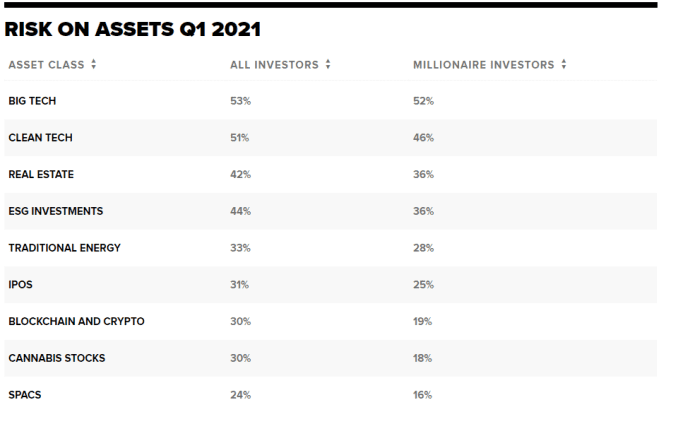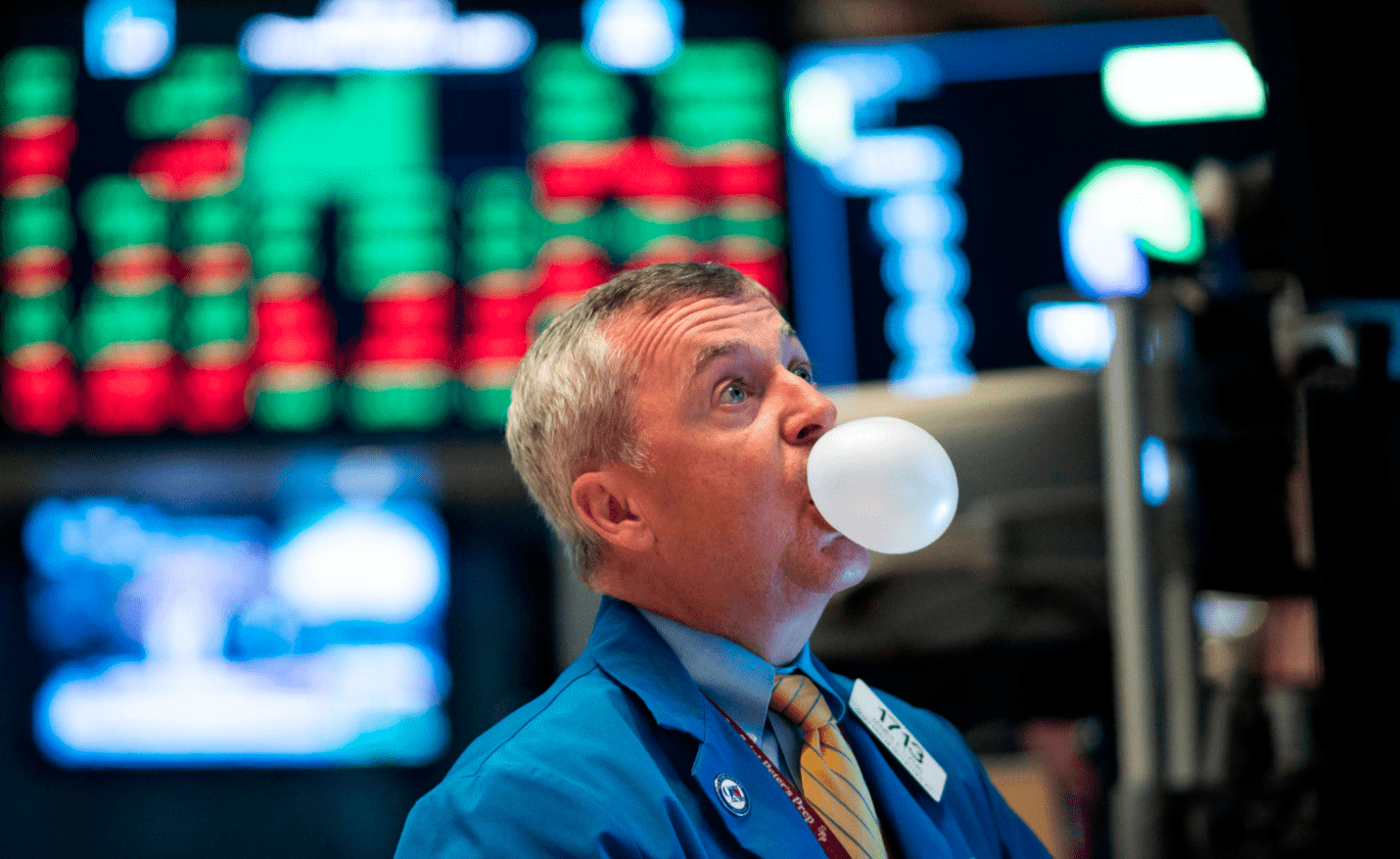If an investor with $1 million or more in the market thinks that a stock bubble is already here — or soon enough one will be coming — what is the correct response? According to a new survey from E-Trade Financial, the answer is to keep investing in stocks, with more emphasis on undervalued sectors of the market.
Only 9% of millionaires surveyed by E-Trade think the market is nowhere near a bubble. The rest of the affluent investor set:
- 16% think we’re “fully in a bubble”
- 46% in “somewhat of a bubble”
- 29% think the market is approaching one
Yet these affluent investors are not running from the market, or parking money in cash. In fact, amid rising bubble fears these same investors say their risk tolerance has increased, significantly, in the first quarter of 2021, and the majority expect stocks to end Q1 with more gains.
A market bubble that can still move higher
The rollout of the Covid-19 vaccines, even if off to a slow start, and the prospect of another even larger stimulus package from President-elect Biden, has investors doing what market history says they should do: look ahead.
“There is a broader recognition of an economy that is improving and signs that the factors are in place for the market to move higher,” said Mike Loewengart, chief investment officer at E-Trade Financial’s capital management unit.
The survey from Morgan Stanley’s E-Trade was conducted from January 1 to January 7 among an online U.S. sample of 904 self-directed active investors who manage at least $10,000 in an online brokerage account. The millionaire data set broken out exclusively for CNBC is comprised of 188 investors with $1 million or more of investable assets.
The seeming contradiction in the continued bullishness at a time of rising bubble fears is not as stark as it seems. This bull market has defied every risk thrown at it and market experts continue to believe the path of least resistance is up. Though the bullish path may require some portfolio tuning-up with greater focus on undervalued sectors of the stock market.
Here are a few findings from the E-Trade survey that speak to where the investor mindset is right now amid the push and pull between risk and reward.
1. Millionaires are more bullish than the broader investing public
There is a lot of chatter right now about an overextended market and a dotcom bubble-like environment, making it hard to tune out the noise for many investors. But among these affluent investors, even with their own bubble fears rising, they are increasingly bullish and more bullish than the broader investor universe. Sixty-four percent of millionaires are bullish, and that is up 9 percentage points from Q4 2020, and that compares to 57% of the broader investor universe that remains bullish.
Among these investors, the percentage that said their risk tolerance has increased in Q1 went up by 8 percent points (from 16% to 24%). The majority (63%) said it remains at the same level as last quarter. Only 13% of millionaires said their risk tolerance has declined.
Wealthy investors are not expecting huge returns, with the largest group expecting the market to rise no more than 5% this quarter, but after the strong run in the markets already on the books, that is a safe, if bullish, response, Loewengart said. Fifty-nine percent of millionaires expect another quarterly gain in the S&P 500, with 43% of those seeing the gain no greater than 5%. Those who think the market is due for a quarterly drop declined from 28% to 22%.
2. More portfolio changes are being made
Even as risk-on remains the mode for many, more investors are tweaking portfolios. The rotation into value stocks, small-cap stocks, and depressed sectors like energy and financials, is already a well-charted phenomenon — the so-called “great rotation” — and these investors are no exception.
The percentage of millionaires who say they are making changes to allocations in their portfolios ticked up for a second quarter in a row, by 6%, to almost one-third overall (32%). The percentage of millionaires moving into cash remains very low (7%) but did tick up from 5% last quarter.
While it has been the growth stocks that outperformed in the past few years, investors are taking the opportunity to move to more cyclically oriented sectors of the market.
“Everything outside of big tech became better potential opportunities,” Loewengart said.
Small-caps have underperformed the S&P 500 since the end of 2018, according to data from CFRA.
The price growth gap between S&P 500 Growth and S&P 500 Value was at its highest in history this past August (dating back to the mid 70s) and is currently, even after some stock rotation, as wide as it was in Dec. 1999, before dotcom crash.
The S&P 500′s 12-month price-to-earnings ratio is at a premium of 45% to its 20-year average. CFRA pegs 2021 earnings increase for the S&P 500 Growth component of the index at 13.3% versus 20.1% for its value group.
3. The stay-at-home trade may be past its peak, but it is permanent
Even with millionaires more likely to say they are making changes to their portfolio allocations, the S&P 500 sector by sector bullishness has not changed that much, according to the survey, showing that for every investor who is taking part in the rotation to value names and more cyclical plays there are still many letting their market money ride on the winners.
“There’s the momentum factor. People want to continue to believe where they’ve seen strong returns it will continue, but some recognize it can’t go up forever,” Loewengart said.
While interest in financials as the sector with the most potential ticked up slightly (by 3%) this quarter, a bet on a swift financial recovery, Loewengart says, overall information technology and health care remain the top sector bets, and that has been the case throughout this bull market. Health care (at 66%) and tech (at 53%) remain the two most popular sectors, and neither saw a decline in interest from investors.
Technology, even for all of its gains, is hard to bet against.
“We can talk a lot about how the stay-at-home trade is over and other segments are poised to do better, but when we see sector expectations being similar, that is also a reflection of the market being tied to tech and the fact that the world has changed as a result of Covid,” Loewengart said. “Some things will not return to way they were before, and we will see multiple expansion in big tech names,” he said.
He added that investors should expect the gains to be more modest, given current valuations, than the opportunity in cyclical sectors where more stimulus and vaccine deployment can drive more significant valuation growth. “There is a potential change of leadership in the market,” Loewengart said.
4. International market opportunities are more attractive
The data is more clear on overseas interest rising than sector bets changing in a significant way within the U.S. market. That’s partly because these millionaires as a rule have a longstanding preference for the U.S. stocks.
Millionaires are shaking their home country bias and taking greater interest in investments outside the U.S., with interest up this quarter 9 percentage points. The percentage of millionaire investors who said international markets were more appealing to them in Q1 2021 rose from 27% to 36%.
“It’s definitely a large move in terms of millionaires, a significant move,” said Loewengart.
Over the last three years, the S&P 500 has outperformed the S&P developed international and emerging market indices. The last time those international markets outperformed the U.S. large-cap index was 2017.
While the dollar has rebounded recently, its broader weakness in recent months is a key element for international stock performance.
“It makes the millionaire set more attuned to the opportunity” Loewengart said.
How much of that new overseas interest is broad-based versus China, specifically, is impossible to know from the survey. “China could be the only member of the G8 that had GDP growth in 2020. That’s a clear indicator that the world outside the U.S., the developing world, is moving past the virus,” he said.
5. The U.S. political risk factor sees a huge drop
If political and election risk was a major factor in Q4, it saw a major downgrade from investors this quarter.
The E-Trade survey’s tail-end caught the Georgia runoff elections and the riots at the Capitol, after which the market set another record, but on the biggest question — the presidential election — millionaire investors are no longer nearly as worried as they were last quarter.
The percentage of affluent investors who view the new presidential administration as the biggest risk to their portfolio declined down from 50% to 30% this quarter. Twenty-six percent of these investors are pessimistic about the prospects for the U.S. economy under President-elect Biden, while 60% expressed some level of optimism, from moderate (38%) to high (22%).
Market volatility, meanwhile, saw a spike among risk factors, from 18% of millionaires viewing it as the biggest portfolio threat to a little over one-quarter (27%).
6. Millionaires are less likely to be risk-on when it comes to the riskiest assets
The latest phase of this bull market, the post-Covid Spring 2020 phase, has been marked by a risk-on appetite for new offerings, IPOs and SPACs, as well as a surge in new asset classes like cryptocurrencies, including bitcoin. Millionaires, even as they continue to be risk-on positioned, are less likely to be interested in these kinds of bets:


